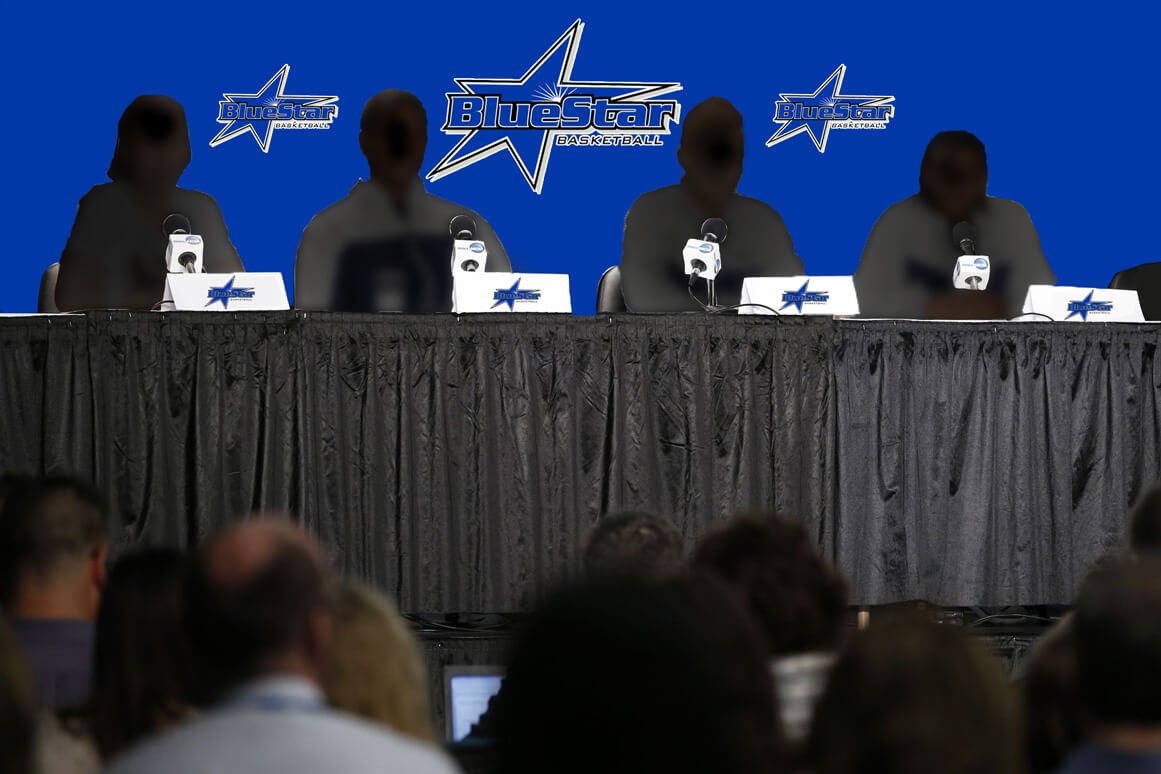Instead of rehashing so many of the points I’ve made about gender and coaching in women’s basketball (see previous posts here, here, here, here and here), I’d like to try a different approach with a new slice of history awaiting us in Indianapolis.
I realize it’s too tantalizing for media and gender activists to resist chiming in on the fact that for the very first time, this Women’s Final Four will have all male coaches, and that somehow this is a troubling, even a bad thing.
It didn’t take long for the issue to come up on a Wednesday conference call with those four men, starting with UConn’s Geno Auriemma, referring to his counterparts this weekend:
“I think the fact that they happen to be men is irrelevant. They’ve done a great job of coaching their teams, and the players have responded in a way that has allowed them to get to the Final Four.
“If we read anything more into that at this time, I think it takes the focus off what the players have done and what the coaches have done and how they’ve earned the right to play in the Final Four.”
This is the correct and proper answer, of course. But surely Auriemma knows that won’t satisfy those who perpetuate a stale narrative about declining numbers of women coaching in women’s basketball and other sports, and the trickle of females coaching men’s sports.
It’s a litany of complaints almost as tiresome as male sportswriters bashing the women’s game when they never bother to cover it.
I was really sorry to read ESPN analyst and former Tennessee star Kara Lawson pile on the gender and coaching discussion this way in a piece published Wednesday at Newsweek:
“It’s a disturbing trend. Why is it so easy to hand over a woman’s program to a male?”
For someone who hasn’t been a coach any more than I have, that’s an audacious thing for Lawson to say. Her other complaints in that story, about the lack of women coaching men and a tiny number of female athletic directors, are beside the point.
The last time I checked, the players are still female. All of ‘em. Shouldn’t this be about improving the sport that young women play instead of pushing female careerism? I don’t think those two issues have to be mutually exclusive.
However, Lawson’s comments feed a narrative dating back to the days of the AIAW, and effectively pit the interests of adult women against progress for female athletes.
Instead of focusing on the gender of the coaches whose teams will be playing this weekend in Indianapolis, how about examining the career paths that they took to get there? And why they are vastly different from many of their elite female coaching peers.
I’m not thinking only of the three newcomers—Scott Rueck of Oregon State, Mike Neighbors of Washington and Quentin Hillsman of Syracuse—but also of Auriemma.
For starters, every single one of them has been a high school or small college coach. Every single one. While a growing number of female coaches are working their way up through the small- and mid-major college ranks, I can count on one finger a high-profile female coach who has gone the prep route—Sherri Coale of Oklahoma.
Rueck won an NCAA Division III title at George Fox University in Oregon, where he coached for 14 years and also taught classes. Neighbors took what he has dubbed “a $58,000 pay cut” as a high school teacher and coach to be the director of basketball operations at Arkansas, where he fetched a lot of Diet Cokes for Gary Blair. Hillsman labored in the high school ranks and as a mid-major assistant for years.
The jobs these men have now were not on the “A” list of college coaching jobs when they got them. Far from it.
There was nothing for Oregon State to “hand over” to Rueck, an alum, when he got to Corvallis in 2010 except the carcass of the catastrophic tenure of LaVonda Wagner. After players and assistants left in droves, complaining of abuse and mistreatment, she was fired (and paid $1.5 million to boot), with only two scholarship players remaining.
He held tryouts, filled out a roster, and somehow fielded a competitive team. The Beavers won only two conference games, but amazingly, he was able to recruit future stars of the program, current seniors Ruth Hamblin and Jamie Weisner, off that season.
“It was absolutely overwelming and daunting,” Rueck said on Wednesday. “Did I ever think we could be here in six years? No way. No way. I did not have enough knowledge at the time to even predict that this could be possible.”
Neighbors had been with Kevin McGuff at Xavier, and then followed him to Washington, which had struggled under Tia Jackson. When McGuff left for Ohio State, Neighbors had to hustle to win back touted California guard Kelsey Plum, who had verballed to the Huskies but re-opened her commitment with the coaching change. A text message she sent him during that time has become famous in recent days: “You stay, I stay.”
On the side, Neighbors, an analytics hound, compiled a 32-page presentation for fellow Pac 12 coaches to “schedule up,” resulting this season in the best conference RPI in the country. For the first time, that conference has two teams in the Women’s Final Four, and neither of them is Stanford.
Hillsman was the recruiting coordinator at Syracuse when the underachieving Keith Cieplicki was dismissed in 2006. When Hillsman was promoted, the Orange were, as Auriemma put it, “someplace that even Syracuse didn’t know there was a program.”
In other words, nowhere. In other words, a place very similar to Storrs, Conn., in 1985.
It may seem hard to believe now, but at the time, Auriemma saw UConn as a stepping-stone for something bigger and better. A female assistant athletic director wanted to hire a woman. Then-Tennessee assistant Nancy Darsch, a leading candidate for the job, ended up at such a bigger and better place, Ohio State.
Auriemma, who coached in the Philly high school ranks before serving on Debbie Ryan’s staff at Virginia, was hired at UConn at a whopping salary of $29,000. In six years, the Huskies reached the Women’s Final Four for the first time. A decade after his hiring, they won their first national championship.
You know the rest of the story.
As the Women’s Final Four field was set, a flurry of coaching moves were being made. Two of the four open “Power 5” jobs have have been filled by men: Kenny Brooks at Virginia Tech and Jonathan Tsipis at Wisconsin. They were successful mid-major head coaches, at James Madison and George Washington, respectively.
So was Colorado’s JR Payne, a female who had been at Santa Clara for two years, and was an assistant under current Oregon coach Kelly Graves at Gonzaga.
What’s more troubling is the profile of women coaches who have been let go. Far too many have a similar background, of never having been a head coach, before they got big-time jobs. Wagner and Jackson fit this description, and Niya Butts (Arizona) and Bobbie Kelsey (Wisconsin) are the latest.
This is indeed a “disturbing trend,” to borrow Lawson’s phrase, but for different reasons than she is suggesting.
Here are some questions she and others concerned about getting more women into coaching need to ask:
- How well are these women being prepared? Have they been head coaches before? Have they done more than just recruit?
- Why have so few ventured below the ranks of high Division I, like Geno, Q, “Nabes” and Scott Rueck?
- Why is it that the lower you go in the women’s coaching pyramid—where there isn’t the money, but where you really learn how to coach—the more male it becomes?
- Why aren’t more women coaching in the high school ranks and on the AAU and summer travel circuits? As Blue Star evaluator Mark Lewis has said, the doors of opportunity are more than wide open for “the silent majority” of this sport to get a terrific grounding in their profession.
Lawson’s remark that “as a woman, you have to be overqualified to be considered,” which is a reference based on a playing career, also is off the mark. That two of four men still left standing didn’t play college basketball at all and the other two played sparingly is irrelevant.
It’s what they have done as coaches that matters, and this is where the development of female coaches in this sport has been seriously lacking. Having more female ADs won’t change that; the change has to come from within the game.
The leadership of women’s basketball, in particular the Women’s Basketball Coaches Association, has to be more vigorous than it has been. Finger-pointing and rattling off low percentages of female coaches isn’t going to resolve anything. It’s certainly not going to make for a better sport.
The WBCA has to be the voice encouraging females, as it will again this weekend at its annual “So You Want to Be a Coach” program, to get in the game, in all aspects of the game, to really learn it, from the bottom up.
I know of so many young, promising women who do want to be head coaches, and who work extremely hard. They’re ambitious, and they’re intelligent and they’re devoted, not just to their careers, but to helping make the women’s game better than it is now.
So many more women need to follow the course of what the four male coaches in the Women’s Final Four have done to get there.
Wendy Parker is a sportswriter and web editor who has covered women's basketball since the early 1990s. She is a correspondent for Basketball Times and formerly covered women's and college sports, soccer and the Olympics at The Atlanta Journal-Constitution. She is the author of "Beyond Title IX: The Cultural Laments of Women's Sports," available on Amazon, and the creator of Sports Biblio, a blog about sports books and history.




